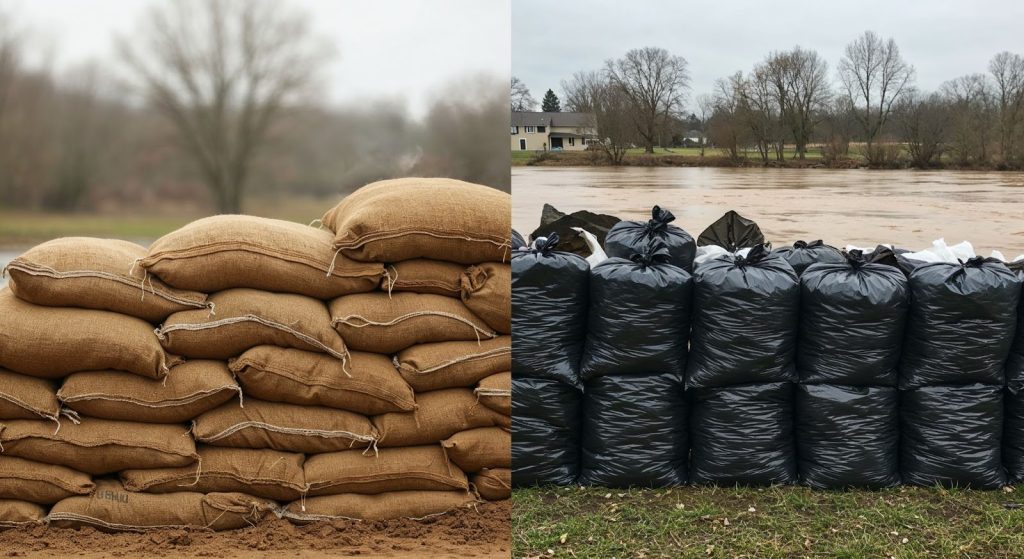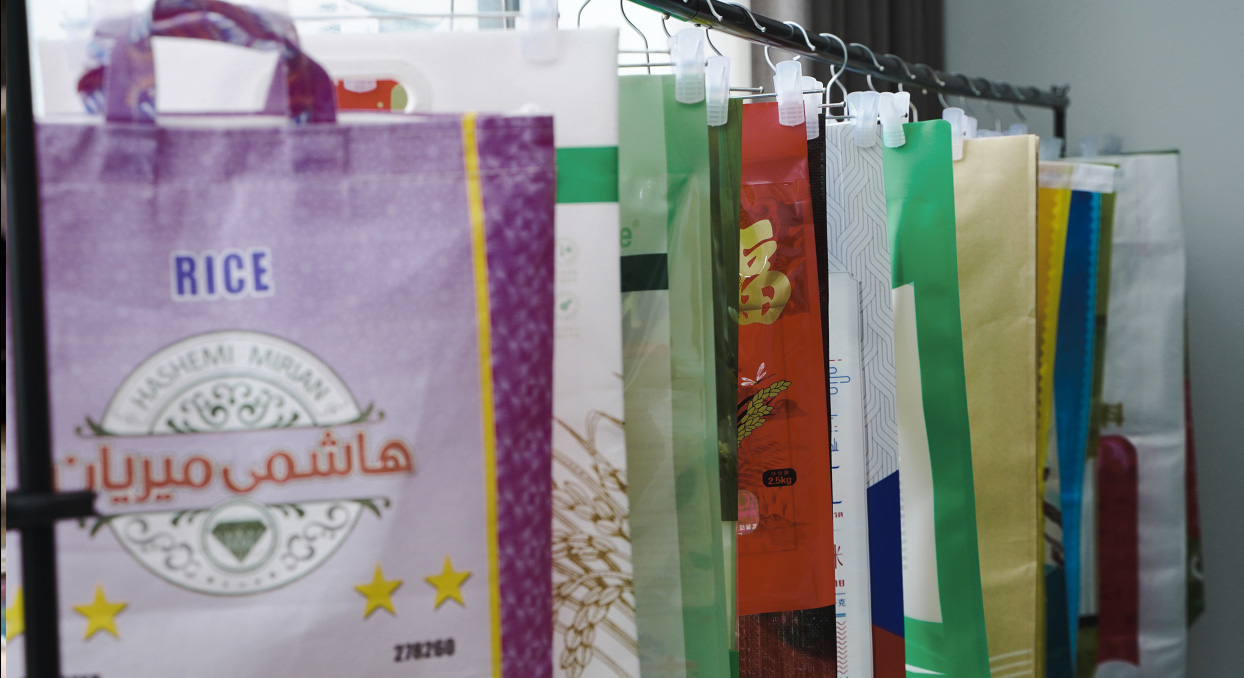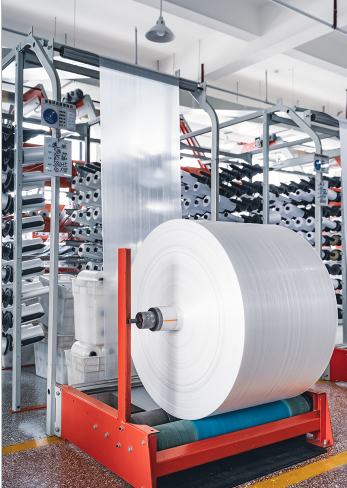洪水は必ずしも予兆となるわけではありません。住宅所有者や中小企業の経営者にとって、迅速かつ費用対効果の高い対策は不可欠です。緊急時に土嚢の代わりに何を使えばいいのかお悩みなら、答えは簡単です。洪水対策に土嚢の代わりに使える、実用的で低コストなDIY代替品が、今すぐにでも実践できるのです。
このガイドでは、DIY土嚢の代替品として最も効果的なもの、その使い方、おすすめの素材、そして複数の方法を組み合わせることで防犯効果を高める方法をご紹介します。ガレージ、店舗、低い玄関など、どんな場所でも、これらの解決策が大きな被害を防げるか、安心できるかの分かれ道となるでしょう。

DIYの防潮堤は、素早く、柔軟に作れて、予算も抑えられます。従来の土嚢は重く、手間がかかり、特に時間が限られている場合は入手が難しい場合があります。一方、DIYスタイルの防潮堤は、既にお持ちの材料で簡単に組み立てることができます。
これらの特徴により、洪水対策用の土嚢の代わりとなる DIY は、短期的な洪水対策としてスマートかつ現実的なアプローチとなります。
洪水対策に土嚢の代わりに使える、DIYスタイルの最も手軽な代替品をいくつかご紹介します。どれも安価で入手しやすい材料を使って、洪水の進路を変えたり、堰き止めたりするのに役立ちます。
最も一般的なDIY防潮堤の一つ。丈夫なゴミ袋に土を入れ、しっかりと閉じて、土嚢のように積み重ねるだけです。
古いタイヤの中央にビニールシートを通すことで、水をせき止めたり、他の防護壁の上に重しとして置いたりできます。周囲の補強に最適です。
出入り口や出入口に合わせて木の板を切って補強します。さらに密閉性を高めるには、ラップや防水シートで覆います。
これらのバッグは濡れると膨張し、保護シールを形成します。必要な時まで乾燥した状態に保ち、水に触れると作動します。コンパクトで清潔、そして簡単に展開できます。
もともと工業用に作られたもので、 FIBCバルクバッグ (ジャンボバッグとも呼ばれます)は、一時的な洪水防止に最適です。緊急時には砂、土、または砂利を詰めてください。
XIFAグループは、耐久性と防水性に関する厳格な品質基準を満たす高強度PP織りバッグとFIBC織りバッグを製造しており、DIYによる洪水対策に最適です。この使用例の詳細については、ガイドをご覧ください。 バルク土嚢:仮締切り建設に最適な選択肢

洪水対策は、使用する資材だけでなく、どのように設置するかが重要です。以下の手順に従って、土嚢の代わりになるDIY資材を適切に設置し、最大限の保護を実現しましょう。
洪水が最も浸水しやすい場所(玄関、ガレージの出入り口、地下室の窓、低い敷地の端など)を特定し、傾斜や凹凸に注意してください。
ニーズに合わせてバリアを選びましょう。屋内での短期使用には、水で活性化するタイプのバッグが適しています。屋外や私道には、合板、FIBC(フレコン)バッグ、または重し付きのゴミ袋をご利用ください。
袋に土を入れ、合板を切って巻き、タイヤとビニールシートを並べるなど、必要な準備をすべて済ませておきましょう。こうすることで、天候が急変した際に迅速に展開できます。
選んだ資材をしっかりと積み重ねたり、並べたりしてください。袋をレンガのように重ねたり、パネルを杭で補強したりしてください。隙間が最小限になるように注意してください。
構造全体を厚手のビニールシートで覆い、レンガ、古タイヤ、土嚢などの重いもので固定します。これにより耐水性が向上し、設置場所を固定できます。
適切に準備された防壁(特に複数の方法を組み合わせる場合)は、洪水による被害を迅速かつ低コストで最小限に抑える最善のチャンスとなります。
| 方法 | 長所 | 短所 |
| ゴミ袋 | 安価、簡単、広く入手可能 | 使い捨て、漏れる可能性がある |
| タイヤ | 耐久性、再利用可能、重量 | 持ち運びが難しく、見た目も悪い |
| 合板 | 大きな障壁に最適 | 防水だけではなく補強も必要 |
| 防水バリア | 柔軟で軽量 | 適切な密封が必要 |
| FIBCバッグ | 大容量、強力 | 充填材が必要 |
ご覧のとおり、土嚢の安価な代替品は効果がないという意味ではなく、環境と材料をよく理解しているという意味です。
あらゆる状況に当てはまる単一の方法はありません。 洪水対策に土嚢の代わりになるDIYの代替品 保護を強化できます。最良の結果を得るには:
XIFAの製品は、特に大規模な施設や商業施設において、このような階層化戦略をサポートします。高度な気象対応については、以下をご覧ください。 ハリケーン対策のためのハルステッドFIBCバッグの究極ガイド
洪水は予測不可能ですが、対応は予測可能である必要はありません。家にあるもので対応する場合も、頑丈で再利用可能なシステムを構築する場合も、DIY土嚢の代替品は、費用、重量、廃棄物を気にすることなく、真の保護を提供します。
で XIFAグループ、 私たちは、洪水対策にも再利用できる信頼性の高い梱包製品で、不動産所有者、地域社会、そして企業の緊急事態への備えを支援します。当社のPP製織バッグとFIBC製織バッグは、丈夫で追跡可能であり、最も必要な時にすぐにご利用いただけます。当社の完全なパッケージソリューションをご覧ください ここ. 今すぐ行動を起こしましょう。少しの準備で、濡れずに済み、お金を節約し、大切なものを守ることができます。




